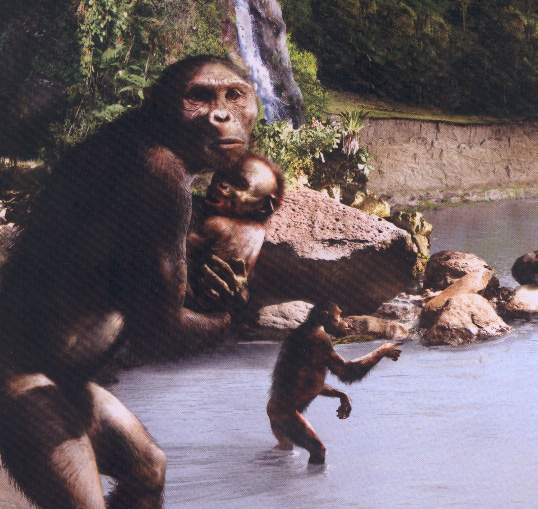
“Intolerance of boredom” as a species trait?
About human origins
Family tree | consciosness | Neanderthal | natural selection | exaptation | anatomy | genes | morphology | spoken language | recent find
The Monkey in the Mirror: Essays on the Science of What Makes Us Human.
Ian Tattersall
New York: Harcourt, 2002.
“writing itself is a process of discovery.”
page = p. 169.

“Intolerance of boredom” as a species trait?
p. 184
150 is the operable size and optimal range for the effective size of human groups to assure cooperation or enforce compliance
p. 199
Exaptation (creative reuse of something in a previously unintended capacity).
pp. 51-52
humans possess large brains = to three (3 X) times the size of hominids
66
| today | 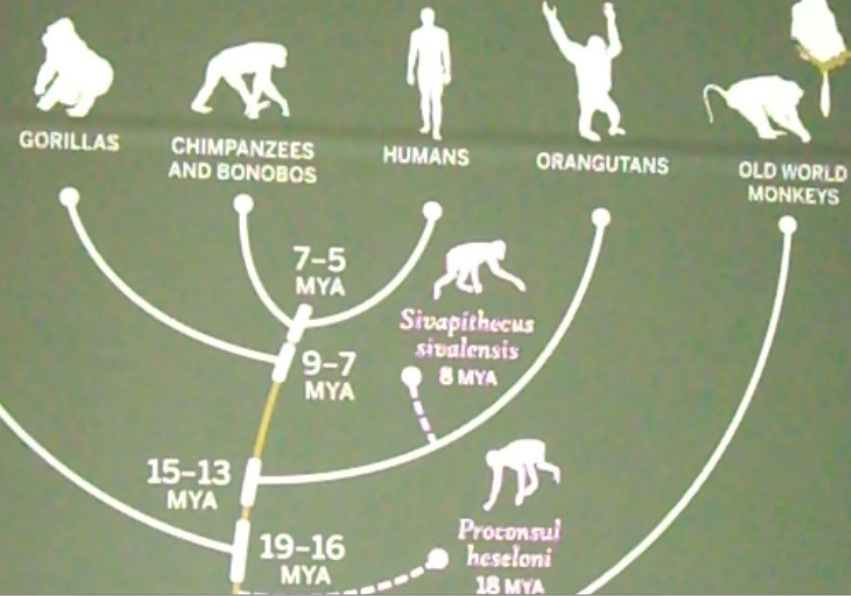 |
Our Cousins |
|---|---|---|
| speciation |
ancestral split |
|
| origins | Primates | |
| Twenty million years ago the loss of forest cover in Africa forced animal migrations. |
Consciousness is representational (not piecemeal) The Human Revolution
77
“Human beings live in a world that they consciously symbolize and recreate in their own minds.”
78
(compare to mirror neurons in George Lakoff)
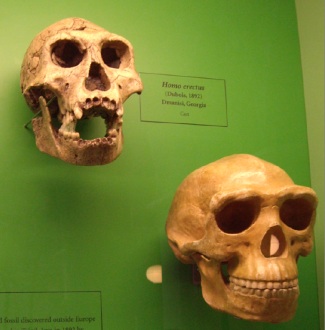
(The cranium reveals incresing brain sizes.)
What sets Homo apart from Australopithecus (Great Southern Apes) &
hominidae’s habilis* and erectus from sapiens species?
* • the earliest tool users / makers
91
Family tree | consciosness | Neanderthal | natural selection | exaptation | anatomy | genes | morphology | spoken language | recent find
The Neanderthal1 tool of choice -- Acheulean hand ax -- after which “prepared core tools turning up...”
117
javelin - like spears of wood for throwing distances
119
A cladogram of our family tree
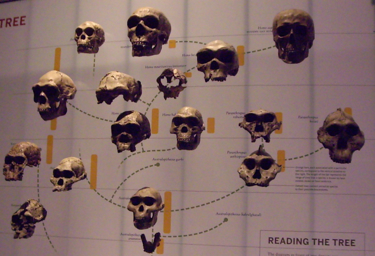
127
Brain capacity led to "real changes in how we perceived our surroundings"
154
Family tree | consciosness | Neanderthal | natural selection | exaptation | anatomy | genes | morphology | spoken language | recent find
“Natural selection is not a creative force and can propel nothing into existence by itself . . . . it can only capitalize on what is already there.”
page 161
“emergent qualities”
the speculation that language is an epigenetic facility
161-62
Pharynx elongation and the consequent (subsequent risk of choking to death) placement of the glottisand epiglottis.
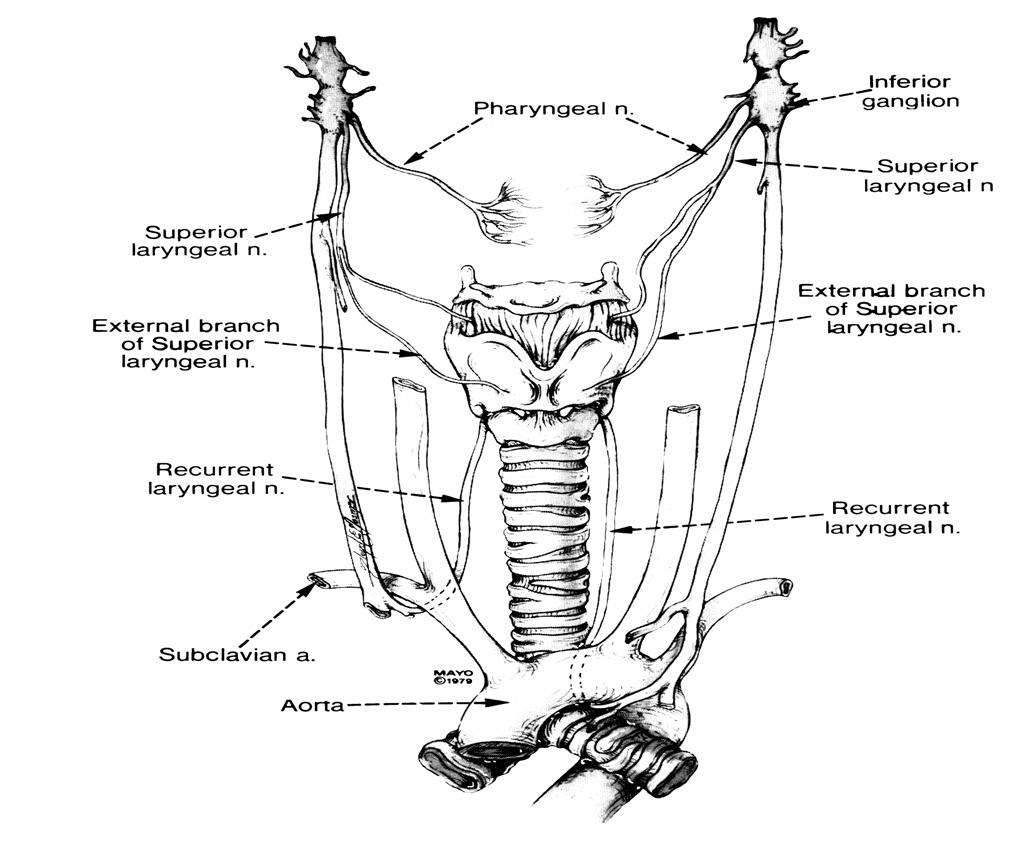
Homo ergaster and Homo heidelbergensis (? habilis?) are two million year old fossils

.6 million or 600,000 (600K) years ago there is evidence in the neck bones of a lengthened pharynx and elongated larynx both are necessities for sound-making that we identify as language.
166
Detailed notes
In Darwin NS meant “descent with modification”
31
“Science is a system of provisional knowledge . . . not ultimate causes.”
30
Evolution by means of natural selection, “explained.”
Speciation is a black box, consider the Amazonian spider monkeys and their close similarities, except they do not interbreed.
the spider monkey’s chromosomal (DNA) peculiarities blocks successful interbreeding among the species
43
Homeobox, genes for eyes in humans and fruit flies are the same genes.
46-47
Abrupt changes in the past are due in large part to (suggestively) recessive traits -- passed on unseen -- until they appear apparently in a sudden expression
47
we are but “the terminal twig” on an evolutionary tree or preferably a bush
54
On intelligence
what is it, how is it manifest diversely and its symbolical quality
66-78
“Human consciousness is very clearly non-algorithmic” it is not a list of how we make “if - then” choices or is it a combination of such logic trees
71
Brains in mammals have retained the pre-mammalian structures (shows evidence for common descent; not design-- see mammal brain discussion)
72
The core of human qualities stems from extended consciousness as a fusion of two disparate capacities:
intuitive and the symbolic
- the intuitive is focused on the here and now while
- the symbolic is aware of the past and the future
73
“intelligence is not a unitary quality” because it is largely situational
74
Morphology (form and function)
The great morphological changes that set Homo sapiens apart from their ancestors
1. bipedalism -- upright posture
2. fabrication--stone tool use
3. modern body -- Turkana boy; legs, brow ridge, jaws, larynx recessed, and facial protrusion suppressed
4. a three fold increase in the size of the cranium (thus leading to brain enlarged)p. 82
“we are not looking at a linear transformation”
83
the emergence of bipedalism -- walking on two feet-- is the great “hominid invention”
105
“with the arrival on earth of symbol-centered behaviorally modern homo sapiens. an entirely new order of being had materialized on the scene (Paleocene).”
141
Family tree | consciosness | Neanderthal | natural selection | exaptation | anatomy | genes | morphology | spoken language | recent find
Neanderthals
155
dividing the environment / world (surroundings) into discrete elements (using symbols)
language can express, yet is independent of emotion (this suggests a blending of emotive--affective and rational/logical proficiencies)
157
“Language is. . .the ultimate symbolic mental function.” no thought is possible without language.
160
exaptation + emergence can be used to understand uniquely human traits
162
Family tree | consciosness | Neanderthal | natural selection | exaptation | anatomy | genes | morphology | spoken language | recent find
"The architecture of speech:" is amove from sounds to spoken syllables and to articulate words.
166-168.
the price of speaking is the fact that the placement of the larynx runs the risk of humans choking to death due to the lengthening of the pharynx -- detectable in the bones of the jaw and neck of fossils
166.
The role of chance in hominid descent from a common ancestor:
“to a remarkable extent, we are, accidental tourists as we cruise through nature in our bizarre ways.”
168.
“our thirst to explain everything about us.”
169.
“our behaviors are not directly programmed by our genes.”
“there is not a direct [correlation /] correspondence of one gene for one character.”
171.
“instead, the significance of timing of when the genes are switched [or turned] on or off” [epigenetic switches = RNAi and methylation]
172.
economics, not biology, dictates many differences in male and female roles
173
“Our comportments are seen as the product of a now vanished hunting and gathering life style, and thus,almost by definition, as somewhat out of sync with today’s environment and needs.” [erroneously assumed by evolutionary psychology].
177
the role of luck -- fortune and chance in natural or sexual selection especially.
180
“natural selection (which is no more than differential reproductive success among individuals.”
187
Family tree | consciosness | Neanderthal | natural selection | exaptation | anatomy | genes | morphology | spoken language | recent find
March 2010 Scientific American reported that about 4 percent of the genome or the DNA possessed by all Eurasian (not Africans) human beings is shared with the Neanderthals; speculating that interbreeding occurred in the Israeli/Palestinian/Jordanian regions after these groups moved out from Africa.
1 In March 2010 Scientific American reported that about 4 percent oo all DNA possessed by all Eurasian (not Africans = Koi San, Bantu, Pygmy, or Nilitics) human beings is shared with the Neanderthals; creating speculation that interbreeding occurred in the Israeli/Palestinian/Jordanian areas as these groups moved out from Africa.
Brain structures | Memory | Mind-brain | Neuronal memory signals | Psycho-pathology | Mirror neurons
The neuronal partnership roles of astrocytes & glia.
Family tree | consciosness | Neanderthal | natural selection | exaptation | anatomy | genes | morphology | spoken language | recent find